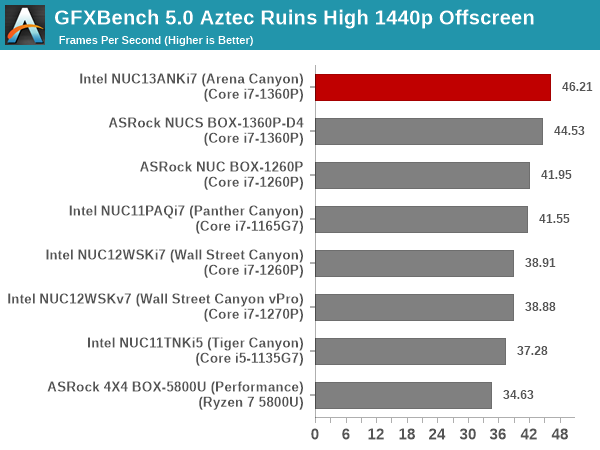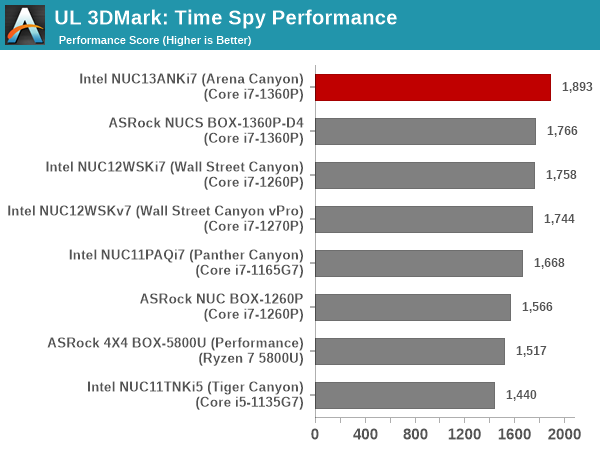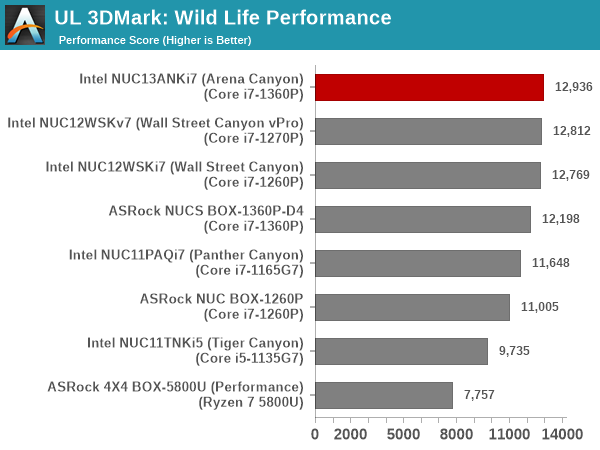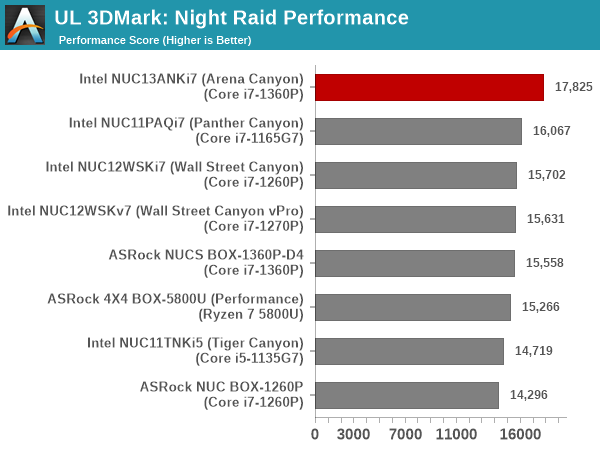Intel NUC 13 Pro Arena Canyon Review: Raptor Lake Brings Incremental Gains
by Ganesh T S on March 27, 2023 9:00 AM ESTGPU Performance: Synthetic Benchmarks
Intel did not make significant changes in the integrated GPU when moving from Alder Lake to Raptor Lake. Process maturity has allowed it to clock the iGPU a bit higher, but the number of EUs remains the same as in the previous generation. GPU performance evaluation typically involved gaming workloads, and for select PCs, GPU compute. Prior to that, we wanted to take a look at the capabilities of the iGPU in the Core i7-1360P. Unfortunately, GPU-Z doesn't yet recognize the 'new' GPU, but HWiNFO has more helpful information tallying with the claimed iGPU specifications.
We have seen earlier that the performance of the Intel Iris Xe Graphics is miles ahead of previous iGPUs from both Intel and AMD. The benchmarks processed on the NUC13ANKi7 back up that aspect.
GFXBench
The DirectX 12-based GFXBench tests from Kishonti are cross-platform, and available all the way down to smartphones. As such, they are not very taxing for discrete GPUs and modern integrated GPUs. We processed the offscreen versions of the 'Aztec Ruins' benchmark.


The 1.5 GHz clock and high EU count expectedly land the Arena Canyon NUC at the top of the file.
UL 3DMark
Four different workload sets were processed in 3DMark - Fire Strike, Time Spy, Night Raid, and Wild Life.
3DMark Fire Strike
The Fire Strike benchmark has three workloads. The base version is meant for high-performance gaming PCs. It uses DirectX 11 (feature level 11) to render frames at 1920 x 1080. The Extreme version targets 1440p gaming requirements, while the Ultra version targets 4K gaming system, and renders at 3840 x 2160. The graph below presents the overall score for the Fire Strike Extreme and Fire Strike Ultra benchmark across all the systems that are being compared.
| UL 3DMark - Fire Strike Workloads | |||

3DMark Time Spy
The Time Spy workload has two levels with different complexities. Both use DirectX 12 (feature level 11). However, the plain version targets high-performance gaming PCs with a 2560 x 1440 render resolution, while the Extreme version renders at 3840 x 2160 resolution. The graphs below present both numbers for all the systems that are being compared in this review.
| UL 3DMark - Time Spy Workloads | |||

3DMark Wild Life
The Wild Life workload was initially introduced as a cross-platform GPU benchmark in 2020. It renders at a 2560 x 1440 resolution using Vulkan 1.1 APIs on Windows. It is a relatively short-running test, reflective of mobile GPU usage. In mid-2021, UL released the Wild Life Extreme workload that was a more demanding version that renders at 3840 x 2160 and runs for a much longer duration reflective of typical desktop gaming usage.
| UL 3DMark - Wild Life Workloads | |||

3DMark Night Raid
The Night Raid workload is a DirectX 12 benchmark test. It is less demanding than Time Spy, and is optimized for integrated graphics. The graph below presents the overall score in this workload for different system configurations.

All of the above benchmarks see the NUC13ANKi7 emerge comfortably on top. Having the fastest iGPU clock and highest power budget mean that this is not a surprising result.











46 Comments
View All Comments
hmurchison - Monday, March 27, 2023 - link
NUC are useless. Plastic computers with huge external power supplies yet people are actually trying to defend this shit. There's a reason why PC sales are in the sh***ter. For decades PC fanboys vomited out how much PC they could buy/build for the price we bought our Mac. Now PC aren't even that affordable. I'd rather buy a M2 Mini as well. I got Thunderbolt, easy upgrade to 10G networking. The PC industry is beyond boring right now.meacupla - Monday, March 27, 2023 - link
I think it's funny you think PC sales are being eaten up by macs.They're not.
The largest market share is from smartphones, and it's primarily Android that has been eating Windows PC market share.
The breakdown of share is basically this
43.9% Android
27.7% Windows
17.1% iOS
6.2% OSX
5.1% Other and Unknown
MrCommunistGen - Monday, March 27, 2023 - link
I don't understand the animosity that exists in the Mac vs non-Mac camps. I have and have used both platforms -- Macs since around 1990 and Windows PCs since around 2002 and continue to use both in my professional career. Each has their place and use cases.Just because a product doesn't match your world-view, regardless of which platform you prefer, doesn't make the other worthless or useless.
Regardless of which platform ultimately takes the performance crown, M2, M2 Pro, etc or Raptor Lake, there's no denying that the various iterations of Apple Silicon have amazing perf/W which is especially beneficial in laptop form-factors. It's also really nice for quiet, high performance computing in small form factors, whether that's a SFF desktop or a laptop.
That said, there are also advantages to the upgradeability of non-Apple devices. The ability to upgrade RAM or storage down the road, whether due to budget limitations at the original time or purchase, or whether you're taking advantage of lower prices in the future can help REDUCE eWaste by allowing an otherwise adequate machine to continue to be used rather than discarded.
It doesn't help Apple's case that in addition to being non-upgradeable they DO charge pretty high prices for upgrading RAM or storage on their machines. +$200 for upgrading from 8GB of RAM to 16GB, or from 256GB of SSD to 512GB is pretty steep (especially since Apple is paying bulk prices) when as an individual you can buy either a 64GB DDR4 3200 SO-DIMM kit or 2TB NVMe SSD for less than $150 at retail.
To directly address the claim that NUCs are useless:
These aren't designed for your average home user. That's not to say that an average home user can't or shouldn't buy a NUC. But really, one of the major intended audience is big corporate offices where the NUC can be VESA mounted to the back of a display and the power brick can be stashed away under a desk.
Also, MOST non-Atom/Pentium/Celeron NUCs (including the 13th generation models in this article) have Thunderbolt.
Circling back to what I hope my key takeaway is:
Can't we all just agree that we all like tech and that new technology is cool rather than just needing to bash on whoever has a different opinion than us?
Samus - Tuesday, March 28, 2023 - link
Ditto. I use both. In fact I have an iPhone, iPad, Intel i7 custom-built gaming PC, Ryzen 5600G HTPC for media, 8th Gen Dell Latitude work laptop and my old Macbook Air for when I need OSX for something like testing a clients software. I have a Pixel 3 without cellular connection to fly my drone (because frankly the iPad and iPhone suck for this) and use Android and Raspberry Pi's for projects of all kinds. I've considered getting an M2-based laptop as soon as they are financially viable to replace my aging iPad Pro as my kitchen table media toy.This is the definition of a competitive industry benefiting the consumer and pushing technology forward. EVERYTHING HAS ITS APPLICATION.
ingwe - Tuesday, March 28, 2023 - link
Spot on. I also don't understand the need to be a fanboy of these gigantic companies that care nothing for individuals.I'm perfectly happy to use whatever fits my application.
block2 - Tuesday, April 4, 2023 - link
Been building PCs since 1999 and do not recall upgrading any. Once they need more RAM the CPU is also too slow. I replaced HD with SSD many years ago before many people had SSD which was huge upgrade. Still using that PC (2.8Ghz AMD Phenom II)!!!Pixol22 - Tuesday, March 28, 2023 - link
I'm pretty sure this is bait, but I'll bite. NUCs are not useless, because NUCs are real computers. Mac minis are gimmick computers more alike to an iPhone than a desktop computer. If you buy a NUC, you can use it to run or host anything you'd like, between multiple operating systems. Yes it matters to me if hardware is supported by Linux or not. You can also upgrade components using industry standard technologies like M.2, SODIMM, SATA. Apple exists in this strange bubble outside the industry and at every single opportunity they will screw over their customers with crazy pricing, hostile repair practices, and expertly designed price brackets designed to cause distress in customers so they just spend $200 more...$200 more...$100 more. Also, I am not sure how you came to the conclusion that PCs are more expensive, as AMD and Intel have caught up to Apple Silicon, and PC manufacturers offer more competitive upgradeable components for a lower cost.Pixol22 - Tuesday, March 28, 2023 - link
As a M1 Mac mini owner, been there, done that. There is a lot to like about that computer, but a lot more limitations that make it so infuriating. First, Apple starts those machines at $600 but Apple charges a whopping $200 for an extra 8 GB of ram, which is ridiculous. Then you have to pay $200 extra for 512gb of storage instead of 256gb of storage. Apple's flash isn't even particularly fast, and it is soldered. So all those people that would worry about SSD failure, I hope you are comfortable de-soldering flash. (If such a thing is possible.) Another annoyance is the base configuration with the M2 has a very limited display engine on the GPU, which means you only get two monitors, and the built in HDMI port is more problematic than its worth as it constantly limits resolution, refresh rate, HDR, and variable refresh rate. Perhaps worst of all, the Mac mini comes with macOS and there is no choice to change the operating system, even though there has been some progress on reverse engineering, it is not useful. Running a server or something on a Mac mini is simply painful. I suggest that most people avoid the Mac mini even though the marketing seems appealing.abufrejoval - Tuesday, March 28, 2023 - link
My oranges have 64GB of RAM not 8GB, and 2TB of NVMe not 250GB.And I use 10Gbit networking via TB, because they run containers and VMs as µ-servers, not sure if Apple allows NICs they don't sell.
You can't even get 64GB of RAM from a Mini, while it's €120 including taxes on Intel or AMD.
You fancy 8TB of NVMe next year, no issue swapping the stick, some NUCalikes offer a 2nd slot.
I seriously wouldn't mind an Apple SoC in my Linux systems, but not with the ballast of MacOS or the prices they charge for meaningful configurations.
Fenturi - Tuesday, March 28, 2023 - link
Until the SSD runs out. Apple needs to not make systems that can't swap the SSD and RAM, none upgradeability on the SSD is a deal breaker.